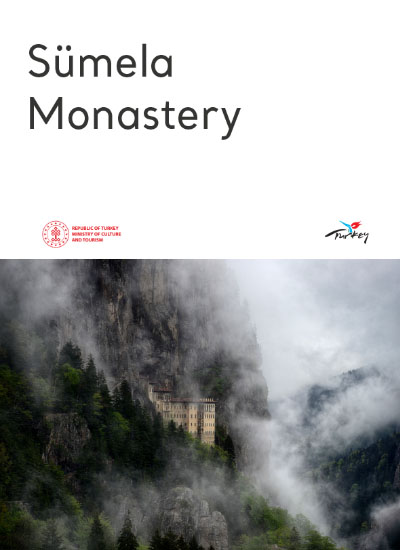The Sumela Monastery is situated on the steep cliffs on the slopes of Karadağ in the Altındere Valley. The monastery, which seems to be stuck to the mountain, takes one’s breath from the beauty of the nature against which it leans. It is thought that the name of the monastery, which is known in full as Panagia Soumela (Sümela Meryemi) or Theotokos Soumela, derives from the Greek word "melas", which means "black". The ancient name of Karadağ is Mela, and "Stou Mela" means "in Mela". The monastery is popularly known as the "Church of the Virgin Mary". It is believed that the first foundations of Sumela were laid during the reign of the Byzantine Emperor Theodosius I (375-395) by Barnabas and Sophronios, priests from Athens. Its foundation is the subject of many legends, and is based on the famous icon (Panagia Soumela) believed to have been made by the Apostle Saint Lucas. The icon was brought by angels to the cave where the church is located, and the Virgin Mary appeared in the dreams of the priests Barnabas and Sophronios, informing them of the icon’s location. The monks, who had arrived in Trabzon unaware of each other’s presence, built the church by erecting a wall in front of the cave where they had discovered the icon. Alexios III (1349-1390) of the Principality of the Komnenos of Trabzon is identified as the primary figure responsible for the establishment of the monastery, as evidenced by the frescoes. Following the conquest of the Eastern Black Sea coast by the Ottoman Empire, the rights of Sümela were preserved. Yavuz Selim I presented two large candles to Sumela, and Mehmet the Conqueror issued an edict that the monastery would not be touched and would continue its activities. In the 18th century, numerous parts of the monastery were renovated, and the frescoes were also renewed. In the 19th century, with the addition of new buildings, the monastery experienced its heyday. In 1923, as a consequence of the population exchange between Turkey and Greece, the monastery was also evacuated. As a result of the meeting of Greek Prime Minister Eleftherios Venizelos with Turkish Prime Minister İsmet İnönü in 1931, the monastery's icons and sacred objects were transported to the Benaki Museum in Athens. In 1952, a new monastery, named "Sumela Monastery", was constructed in Veria. The icons and relics from the Benaki Museum were subsequently relocated to this new site. Sumela was a significant pilgrimage destination for the Black Sea Greeks and renowned for its healing ayazma (sacred spring). It was also a centre for the training of monks. The monastery was regarded as sacred due to its association with an icon that was believed to have performed a miracle. After reaching Sümela by car, a path is followed through the forest. The building complex includes the main rock church, several chapels, a kitchen, student rooms, a guest house, a library, and a sacred ayazma, spread over a large area. The women's monastery, "Hagia Barbara," situated at the cliff’s end of the driveway, welcomed visitors for the great feast on 15 August. A narrow and long staircase leads to the main entrance. Guard rooms are situated adjacent to the gate, and Turkish art influences can be observed in the rooms, cupboards, cells and hearths in the buildings surrounding the inner courtyard. The structure with a large balcony covering the front face of the slope was utilised as a guest and monk dormitory. The interior and exterior walls of the rock church, which is the main unit, and the adjacent chapel are decorated with frescoes. The wall of the rock church facing the courtyard displays frescoes from the reign of Alexios III, while the chapel's frescoes date from the early 18th century. The primary subjects depicted are biblical scenes and depictions of the life of Jesus Christ and the Virgin Mary. The works, which started in September 2015 and lasted 3.5 years, involved the restoration of the aqueducts and the renewal of the stairs leading to the monastery. Approximately 4,000 tonnes of rocks were cleaned, and a 300-metre walkway was arranged. In addition to a chapel with frescoes depicting "Heaven and Hell" and "Death and Life", a chapel reached by a secret passage, as well as the "Ordeal Room" and the "Watching Chapel", which served as an outpost, were also uncovered. The monastery and church complex is on the UNESCO "Tentative List of World Cultural Heritage".
SÜMELA MONASTERY


